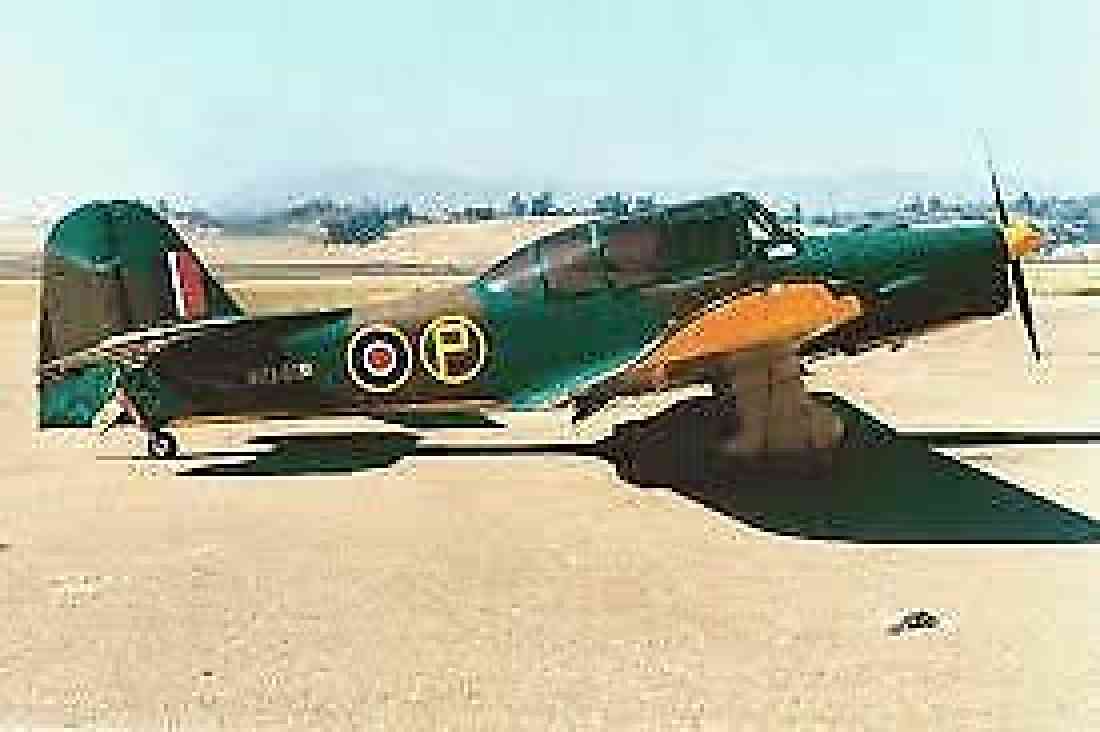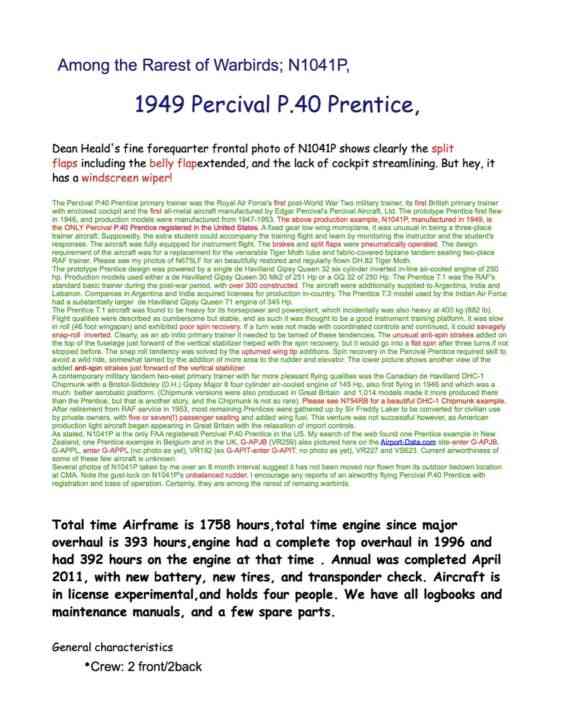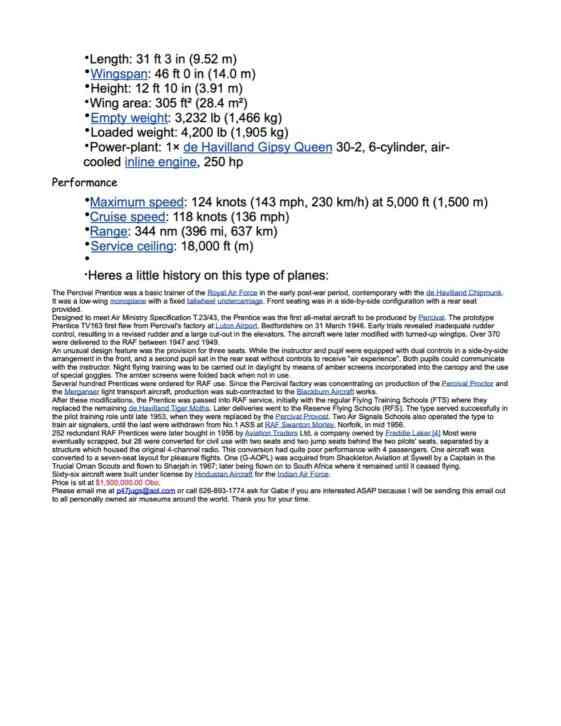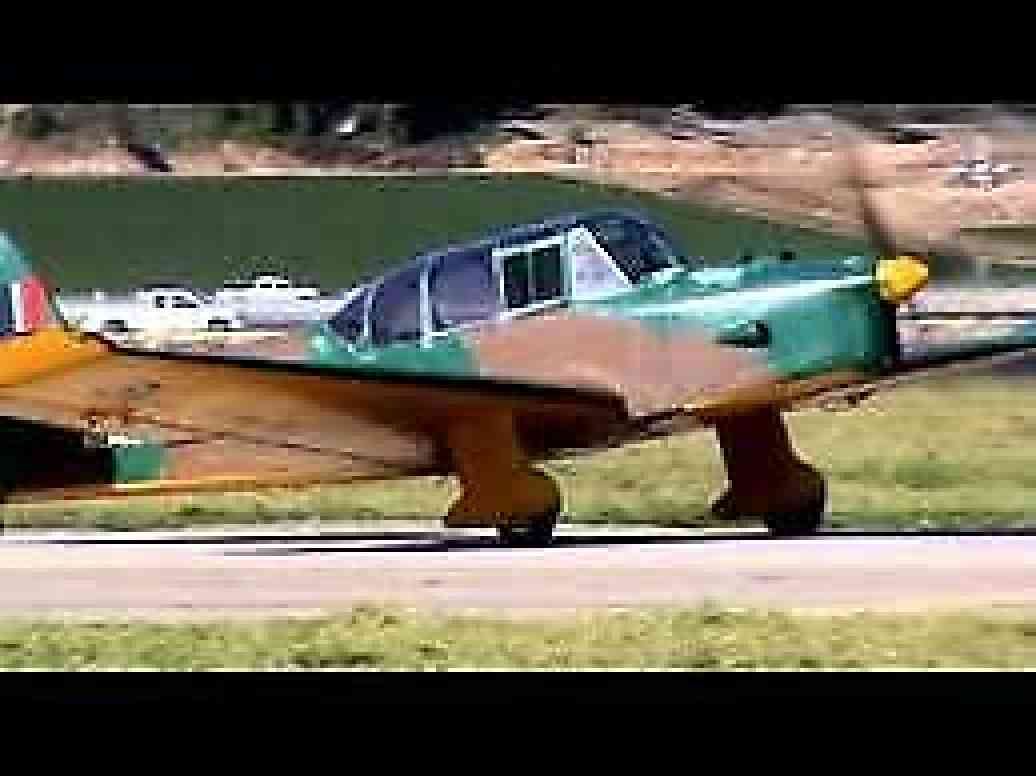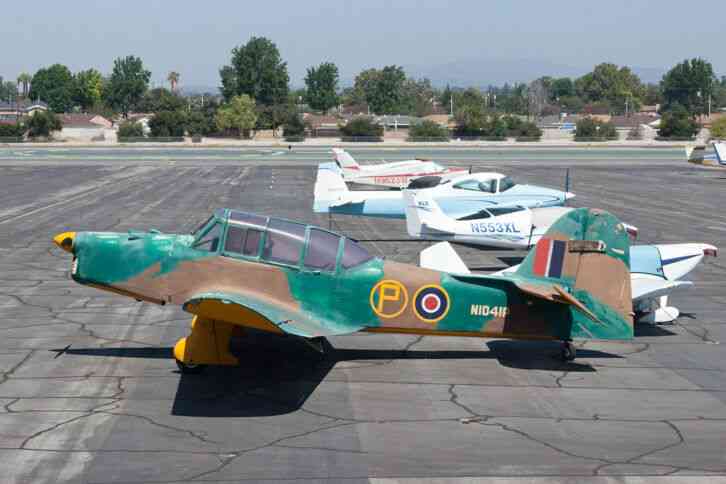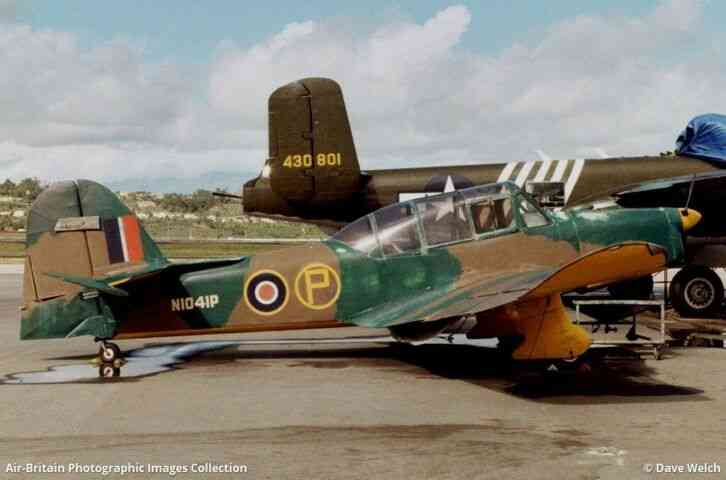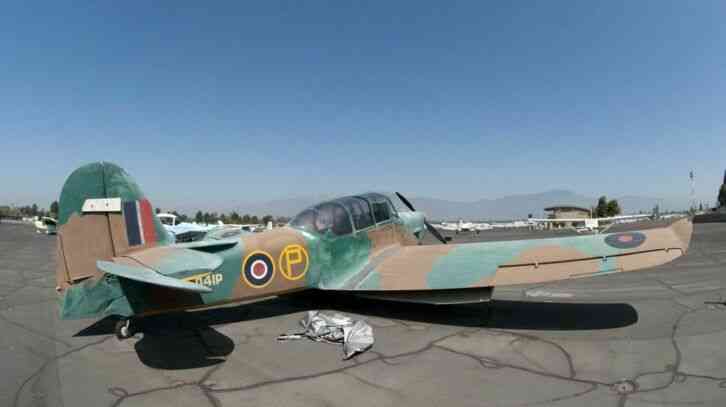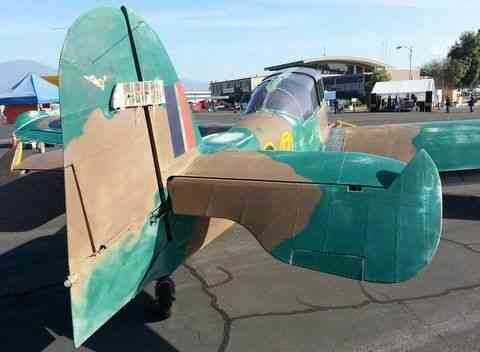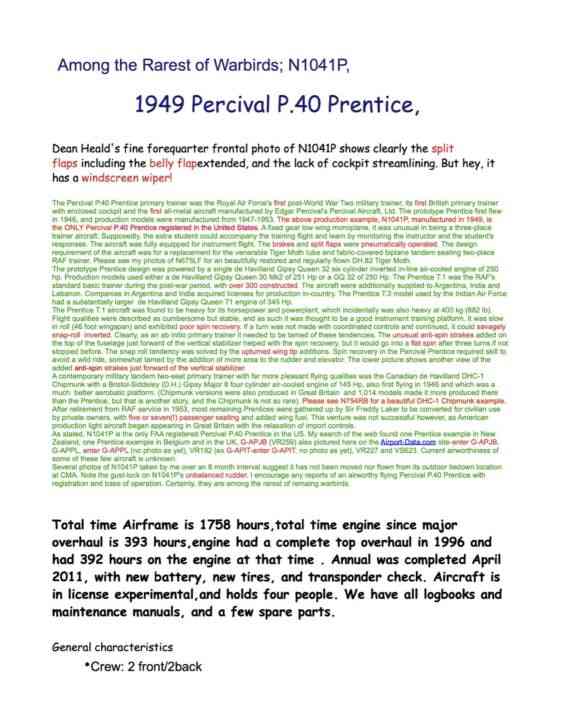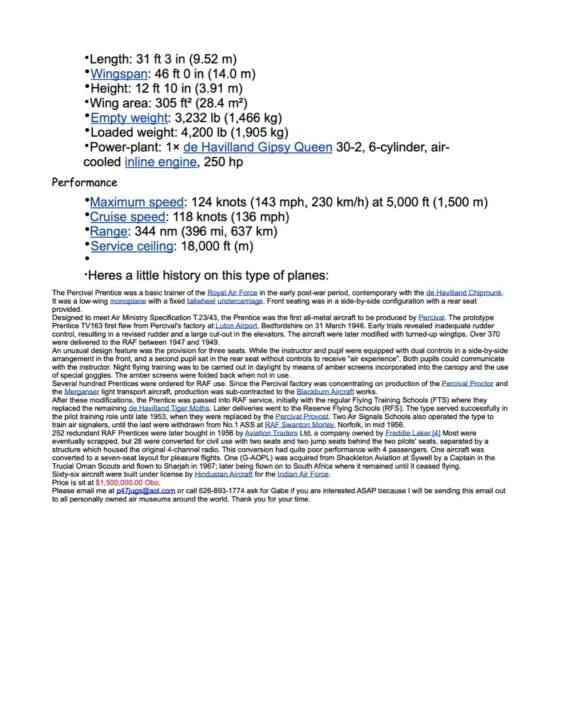“English military Camo patina. Needs some control surface work.” Percival 1949 Prentice Among the.
Item specifics
| Used |
| “English military Camo patina. Needs some control surface work.” |
| Make: | Percival | Model Year: | 1949 Prentice |
flaps including the belly flapextended, and the lack of cockpit streamlining. But hey, it has a windscreen wiper! The Percival P.40 Prentice primary trainer was the Royal Air Force"s first post-World War Two military trainer, its first British primary trainer with enclosed cockpit and the first all-metal aircraft manufactured by Edgar Percival"s Percival Aircraft, Ltd. The prototype Prentice first flew in 1946, and production models were manufactured from 1947-1953. The above production example, N1041P, manufactured in 1949, is the ONLY Percival P.40 Prentice registered in the United States. A fixed gear low wing monoplane, it was unusual in being a three-place trainer aircraft. Supposedly, the extra student could accompany the training flight and learn by monitoring the instructor and the student"s responses. The aircraft was fully equipped for instrument flight. The brakes and split flaps were pneumatically operated. The design requirement of the aircraft was for a replacement for the venerable Tiger Moth tube and fabric-covered biplane tandem seating two-place RAF trainer. Please see my photos of N675LF for an beautifully restored and regularly flown DH.82 Tiger Moth.The prototype Prentice design was powered by a single de Havilland Gipsy Queen 32 six cylinder inverted in-line air-cooled engine of 250 hp. Production models used either a de Havilland Gipsy Queen 30 Mk2 of 251 Hp or a GQ 32 of 250 Hp. The Prentice T.1 was the RAF"s standard basic trainer during the post-war period, with over 300 constructed. The aircraft were additionally supplied to Argentina, India and Lebanon. Companies in Argentina and India acquired licenses for production in-country. The Prentice T.3 model used by the Indian Air Force had a substantially larger de Havilland Gipsy Queen 71 engine of 345 Hp.The Prentice T.1 aircraft was found to be heavy for its horsepower and powerplant, which incidentally was also heavy at 400 kg (882 lb). Flight qualities were described as cumbersome but stable, and as such it was thought to be a good instrument training platform. It was slow in roll (46 foot wingspan) and exhibited poor spin recovery. If a turn was not made with coordinated controls and continued, it could savagely snap-roll inverted. Clearly, as an ab initio primary trainer it needed to be tamed of these tendencies. The unusual anti-spin strakes added on the top of the fuselage just forward of the vertical stabilizer helped with the spin recovery, but it would go into a flat spin after three turns if not stopped before. The snap roll tendency was solved by the upturned wing tip additions. Spin recovery in the Percival Prentice required skill to avoid a wild ride, somewhat tamed by the addition of more area to the rudder and elevator. The lower picture shows another view of the added anti-spin strakes just forward of the vertical stabilizer.
A contemporary military tandem two-seat primary trainer with far more pleasant flying qualities was the Canadian de Havilland DHC-1 Chipmunk with a Bristol-Siddeley (D.H.) Gipsy Major 8 four cylinder air-cooled engine of 145 Hp, also first flying in 1946 and which was a much better aerobatic platform. (Chipmunk versions were also produced in Great Britain and 1,014 models made it more produced there than the Prentice, but that is another story, and the Chipmunk is not so rare). Please see N754RB for a beautiful DHC-1 Chipmunk example. After retirement from RAF service in 1953, most remaining Prentices were gathered up by Sir Freddy Laker to be converted for civilian use by private owners, with five or seven(!) passenger seating and added wing fuel. This venture was not successful however, as American production light aircraft began appearing in Great Britain with the relaxation of import controls.
As stated, N1041P is the only FAA registered Percival P.40 Prentice in the US. My search of the web found one Prentice example in New Zealand, one Prentice example in Belgium and in the UK, G-APJB (VR259) also pictured here on the Airport-Data.com site-enter G-APJB, G-APPL, enter G-APPL (no photo as yet), VR192 (ex G-APIT-enter G-APIT, no photo as yet), VR227 and VS623. Current airworthiness of some of these few aircraft is unknown.
Several photos of N1041P taken by me over an 8 month interval suggest it has not been moved nor flown from its outdoor tiedown location at CMA. Note the gust-lock on N1041P"s unbalanced rudder. I encourage any reports of an airworthy flying Percival P.40 Prentice with registration and base of operation. Certainly, they are among the rarest of remaing warbirds.Total time Airframe is 1758 hours,total time engine since major overhaul is 393 hours,engine had a complete top overhaul in 1996 and had 392 hours on the engine at that time . Annual was completed April 2011, with new battery, new tires, and transponder check. Aircraft is in license experimental,and holds four people. We have all logbooks and maintenance manuals, and a few spare parts. General characteristics•Crew: 2 front/2back•Length: 31 ft 3 in (9.52 m)
•Wingspan: 46 ft 0 in (14.0 m)
•Height: 12 ft 10 in (3.91 m)
•Wing area: 305 ft2 (28.4 m2)
•Empty weight: 3,232 lb (1,466 kg)
•Loaded weight: 4,200 lb (1,905 kg)
•Power-plant: 1× de Havilland Gipsy Queen 30-2, 6-cylinder, air- cooled inline engine, 250 hpPerformance•Maximum speed: 124 knots (143 mph, 230 km/h) at 5,000 ft (1,500 m) •Cruise speed: 118 knots (136 mph)
•Range: 344 nm (396 mi, 637 km)
•Service ceiling: 18,000 ft (m)••Heres a little history on this type of planes:The Percival Prentice was a basic trainer of the Royal Air Force in the early post-war period, contemporary with the de Havilland Chipmunk. It was a low-wing monoplane with a fixed tailwheel undercarriage. Front seating was in a side-by-side configuration with a rear seat provided.
Designed to meet Air Ministry Specification T.23/43, the Prentice was the first all-metal aircraft to be produced by Percival. The prototype Prentice TV163 first flew from Percival"s factory at Luton Airport, Bedfordshire on 31 March 1946. Early trials revealed inadequate rudder control, resulting in a revised rudder and a large cut-out in the elevators. The aircraft were later modified with turned-up wingtips. Over 370 were delivered to the RAF between 1947 and 1949. An unusual design feature was the provision for three seats. While the instructor and pupil were equipped with dual controls in a side-by-side arrangement in the front, and a second pupil sat in the rear seat without controls to receive "air experience". Both pupils could communicate with the instructor. Night flying training was to be carried out in daylight by means of amber screens incorporated into the canopy and the use of special goggles. The amber screens were folded back when not in use.Several hundred Prentices were ordered for RAF use. Since the Percival factory was concentrating on production of the Percival Proctor and the Merganser light transport aircraft, production was sub-contracted to the Blackburn Aircraft works.
After these modifications, the Prentice was passed into RAF service, initially with the regular Flying Training Schools (FTS) where they replaced the remaining de Havilland Tiger Moths. Later deliveries went to the Reserve Flying Schools (RFS). The type served successfully in the pilot training role until late 1953, when they were replaced by the Percival Provost. Two Air Signals Schools also operated the type to train air signalers, until the last were withdrawn from No.1 ASS at RAF Swanton Morley, Norfolk, in mid 1956. 252 redundant RAF Prentices were later bought in 1956 by Aviation Traders Ltd, a company owned by Freddie Laker.[4] Most were eventually scrapped, but 28 were converted for civil use with two seats and two jump seats behind the two pilots" seats, separated by a structure which housed the original 4-channel radio. This conversion had quite poor performance with 4 passengers. One aircraft was converted to a seven-seat layout for pleasure flights. One (G-AOPL) was acquired from Shackleton Aviation at Sywell by a Captain in the Trucial Oman Scouts and flown to Sharjah in 1967; later being flown on to South Africa where it remained until it ceased flying. Sixty-six aircraft were built under license by Hindustan Aircraft for the Indian Air Force.
Price is sit at $1,500,000.00 Obo.
Please email me at p47jugs@aol.com or call ask for Gabe if you are interested ASAP because I will be sending this email out to all personally owned air museums around the world. Thank you for your time. Current date: 2020-06-24
